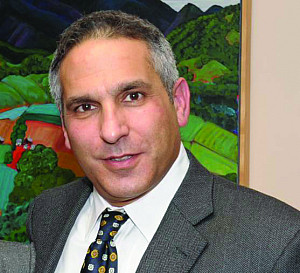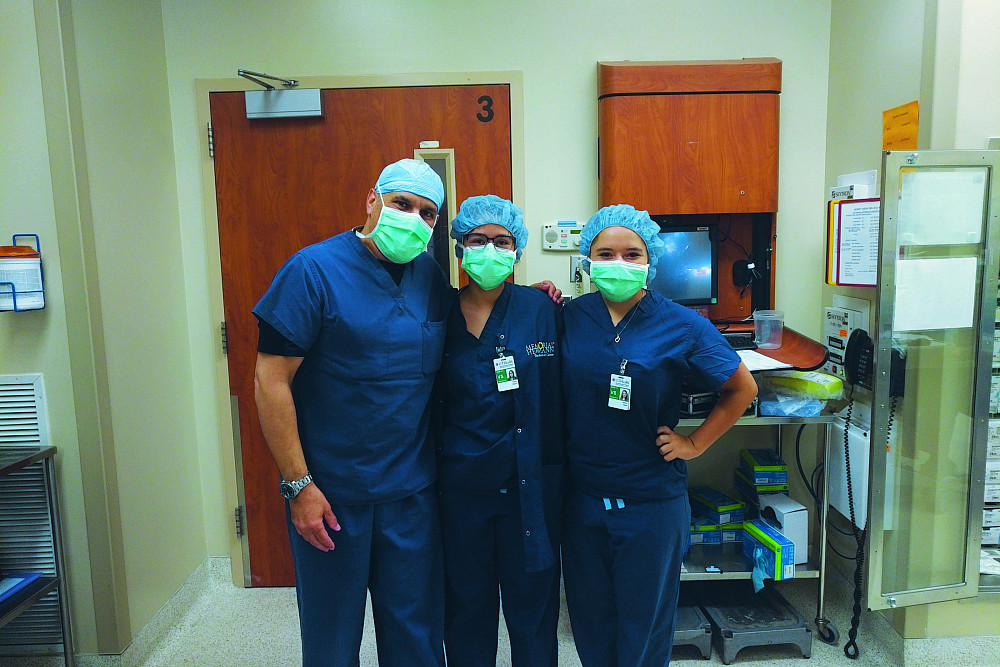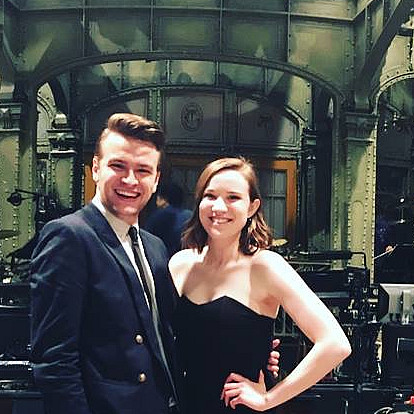News
Southwestern Undergrads Study Cardiovascular Medicine at UTHealth
Dr. Eyal Porat P’21 coordinates summer internships for SU students.
March 20, 2019
March 20, 2019
Open gallery

Last summer, three Southwestern students stood near the head of a patient undergoing coronary artery bypass surgery. Viewers of medical dramas on television might be surprised to know that “there was not a lot of blood involved,” says Karen Rativa ’20. Athena Pinero ’20 agrees: “It’s fairly contained. There are a lot of tubes, a lot of tools, and a lot of machines, though.” The third student, Kirhyn Stein ’20, adds, “The only surprising thing was the smell of the cauterizing.” Apparently, surgeons must literally burn patients’ flesh to decrease blood loss during incisions. All three students confirm that the odor is off-putting at first. “But after a while,” Stein assures me, “you get used to it.”
Ever cool under pressure, even when a human life is at stake, Rativa, Pinero, and Stein were the first Southwestern interns participating in the Undergraduate Summer Research Curriculum of the Sciences Research and Education Program, hosted by the Department of Cardiothoracic and Vascular Surgery at the University of Texas Health Science Center of Houston (UTHealth). The internships were created by Dr. Eyal Porat, a professor of cardiothoracic and vascular surgery at UTHealth. “I saw that a lot of students at Southwestern are seeking a career in the medical field, and it just made sense to create an opportunity for them.”

From the lecture hall to the operating room
The internship program lasted eight weeks and entailed three parts: attending talks at UTHealth’s McGovern Medical School, shadowing and observing clinical and operating-room (OR) procedures, and conducting medical research. Although their schedules varied throughout the summer, the work day usually began around 7 a.m., with Rativa, Pinero, and Stein watching classroom lectures, presentations by fellows, or morbidity and mortality conferences. Rativa, a biology major and certified nursing assistant who hails from Colombia and has wanted to be a doctor since childhood, enjoyed this didactic component even though the atmosphere in the lecture halls sometimes turned tense: “the residents are explaining each step in a patient’s care, and the surgeon would jump in and bombard one of the residents, making them think and connect the dots.” Watching such interactions served as eye-opening preparation for the rigors of medical school and residency, which Rativa plans to pursue after graduating from Southwestern.

From 8 a.m. to 1 p.m., the interns were often shadowing Porat during clinicals, learning more about the patients who would soon be undergoing surgery. Otherwise, they were scrubbing in on complicated open-heart surgeries, including aortic repairs and coronary bypasses. Despite being undergraduates, the three students were invited to watch at close range, often standing near the anesthesiologist or peering through a paper screen around the patient’s head. “Dr. Porat would teach us about the heart, explain that this is a smoker’s lung, and show us what he was doing,” recalls Stein, a biochemistry major who also hopes to attend med school after graduation—and who, coincidentally, is Ayala Porat’s resident assistant this year. “You want to ask questions, but you don’t want to get in anyone’s way [because] someone’s life is literally right there. But as we got more familiar with the surgeries, we got more comfortable, and we knew when to ask. But it was still shocking to watch them open the chest, cranking it open so [the surgeons] could see everything.” For Stein, observing surgeries was the most valuable and enlightening part of the experience.
Pinero, a biology major and psychology minor, notes that surgery in an OR is much different from what occurs in an emergency room (ER). “I’ve volunteered in an ER before, and it is as gruesome and bloody” as you might expect, she says. But in the OR at UTHealth, “if there are no complications, it’s nice and pristine,” primarily because surgery requires extensive sterilization. In fact, because the patient is “covered up—even their face— [and] the surgeons are only working with a small area of the body,” she and the other interns could focus on the organs and tissues without any squeamishness.
“[Dr. Porat] taught us to follow our dreams because nothing else matters.”
Rativa, who is already considering orthopedics as a specialty down the line, loved witnessing the teamwork required of such extensive surgeries, but she also appreciated Porat’s mentorship and the learning process taking place in the OR. “He’d have us right near the patient, explain the whole process, [and] ask questions,” she says. “[We’d realize] we needed to study the anatomy of the heart, which would encourage us so we’d be prepared for his next patients.”
All three interns did laughingly admit that the surgeries tested their stamina and/or their bladder control. After all, observing four- and five-hour operations meant a lot of standing without going to the bathroom.
Undergraduate versus medical research
The third component of the UTHealth experience was medical research. Heading back to McGovern Medical School each afternoon, the students embarked on individual projects under the supervision of Dr. Harleen K. Sandhu, assistant professor and director of clinical research and development in the Cardiothoracic and Vascular Surgery Department. Stein worked on a systematic review of literature about the incidence and outcomes of aortic dissection in women of childbearing age—a project that is still underway. Rativa worked on aortic aneurysms in the same demographic. If all goes according to plan, the interns’ research will contribute to a grant that will help open a clinic for women who suffer from these potentially fatal conditions.
Unlike science research at Southwestern, much of this work took place not in a laboratory but rather in front of a computer. The literature review required methodical keyword searches, detailed documentation of every article, evaluation of each paper’s relevance, and excerpting of material that fit into the topics at hand. Stein found the work challenging because it was not a kind of research she had engaged in before: “When we started the research, it was really hard because we didn’t know what to do at all.” Rativa echoes Stein: “It was a lot of data analysis. I wasn’t used to that kind of research, … [but] I got to see things I’d never learned before. Later, our PI [principal investigator, Sandhu] said, ‘You’re doing stuff that graduate students are doing.’ So this is something I really value.”
Pinero, meanwhile, worked with Sandhu on developing and validating an aortic disease quality of life survey—a collaboration that may lead to coauthoring a paper. “The research part was just really cool because I love research. I really enjoyed that, even if I was just entering data and learning how to use Excel, because it will help with my capstone. Reading up on the literature on the quality of life survey and medical research is a lot different from the research we do here [at SU]. The research we do here is intense, but medical research is just different.”

For Stein, the internship initiated by Porat furthered her understanding of how medical schools, hospitals, and ORs work. “It also helped me develop my skills in talking to doctors. It’s really different talking to them sometimes because they’re so busy.” In addition to the interpersonal skills she learned, Stein reflects on how the internship connects with her coursework and future plans back at Southwestern. “It solidified my decision to go premed because I love chemistry so much, and I can see [how] different drugs and pharmaceuticals that we learned about in class were coming up as we saw different heart problems [in the clinic].”
As she looks forward to future internship and career opportunities, including possibly returning to work with Porat and Sandhu, Stein says, “I feel stronger in my own abilities. I was nervous going in because I didn’t know anything, but I was able to jump in. I just taught myself stuff, I talked to people a lot, and I just ended up overcoming it. … Now I feel confident. Even if I don’t know enough, I can continue working on it, and I’ll get it eventually.”
Pinero says, “It was all amazing. Going to the lectures and just immersing myself in the medical school at McGovern was helpful.” Being able to witness surgeries and study the human body in a way that cannot be conveyed in textbooks—such as physically feeling how a smoker’s lung compares with that of a nonsmoker or seeing up close how fatty deposits develop in healthy versus less healthy patients—was a highlight for Pinero. “A lot of times in undergrad, you focus on a molecular level, but seeing things on a macro level—like if a patient complains, ‘my arm hurts’—that can mean more. It helps me piece things together in class better.”
But part of her discovery was also learning what she does not want to do: “I learned it’s OK to be uncertain about medical school. This experience helped me decide I want to be a physician’s assistant [PA] in grad school instead.” Pinero credits Porat with giving her the confidence to change her mind and valuing the ability to choose not to pursue certain paths. “He made it sound like not knowing was OK. We’re under so much pressure to … have a plan in place, but you don’t have to follow the order that you think you should. He taught us to follow our dreams because nothing else matters.”
Rativa is grateful for the professional experience as well as the chance to network. “I was able to talk to residents, surgeons, doctors, medical students, undergraduates [from UT, Baylor, and Rice], PAs—all of these professionals who I wouldn’t have met just doing research at a university,” she says. “It was really cool to see the knowledge gaps and how everybody works together to fill those.” The internship has already had a tremendous impact on Rativa’s schoolwork. “Coming back to SU, it made me use these techniques in the everyday activities I do,” she says. “So in my upper-level classes, when I have to look up an article, I know the keywords I should be using; I know the databases; I can see how results are manipulated by the keywords. And I can share with other students how this experience has changed my life. This has given me the tools to keep trying to achieve my goals of getting to medical school.”
A mentor and a teacher
And as for the surgeon who put this new program together? All three students gush about Porat’s character and willingness to share his expertise. “He is a very caring physician,” Rativa says. “I learned so much from him, but the one thing I won’t forget—he kept telling us this—[is that] we’re here to serve people. That’s the thing that’ll stick with me forever. It’s not about students who know everything by the book; it’s about students who know that medicine is about caring.”
Unlike the stereotypical surgeons who divorce themselves from the humanity of their patients, Porat modeled genuine interest in and compassion for the individuals under his care. Rativa was impressed that he could share facts about his patients’ lives that weren’t found in their medical records. “He’s very involved with his patients. In the clinical area, you just know he goes above and beyond to connect with his patients, and that’s something. I think he was the biggest lesson I learned.”
Pinero agrees about Porat’s dedication to providing exemplary care and caring. “He and Dr. Sandhu are just so down to earth and really care about their patients, not just their status. They were just so inspirational in so many ways. He’s very passionate about what he does. It’s important that you’re passionate about it because people’s lives are in your hands.” That sensitivity extended to Porat’s mentoring of the SU interns as well. “He was so helpful,” Pinero continues. “He always stressed to us, ‘This is your experience. … I will try everything to help you have the experience you want to have.’ We always felt comfortable talking to him about anything. He taught us a lot, too. He was definitely a teacher, a role model, and a resource for sure.”
Stein also appreciated Porat’s mentorship, especially because he exhibits the interpersonal skills that she has seen lacking in some of the physicians she has encountered in her job as a standardized (or simulated) patient. “All he wanted was for us to be learning something. When we did clinics with him, he would do postsurgery follow-ups. He would ask patients, ‘How are you doing? How have you been walking? Are you taking your meds?’ Then, he’d debrief us and tell us why he was asking those questions and share the backstory so we weren’t lost. Doctors in other internships sometimes don’t care, so he made sure we understood and also genuinely asked us how we were doing. He was really, really accommodating the whole time.”
The respect is clearly mutual. Porat says that working with the intrepid undergraduate trio was “refreshing” compared with teaching medical students and residents: “Undergraduates are much more curious, and that’s a very good thing. I told them, ‘Never lose your curiosity. There are no silly questions; there are only silly answers.’ … If someone is curious about something, someone wants to learn something. Respect that. Undergraduates are empty pages: they want to learn, they want to know, and that’s what I like about them.”
And even though they were there to learn during their internship, Rativa, Pinero, and Stein nevertheless contributed to Porat’s surgical team. “They’re amazing, bright young students. They were very hardworking, and they were very dedicated,” he says warmly. “We benefit from their presence as well because it brings the best out of everybody.” Because of the success of this summer’s experience, the SU team hopes to reunite with their mentor and his colleagues either over winter or spring break or else in a future summer. Porat is delighted to keep the door open for them.
Dr. Porat says Pinero, Stein, and Rativa are “amazing, bright young students” who brought “the best of of everybody.”
For this parent, role model, and teacher, then, providing the SU interns with clinical and theoretical knowledge was only part of the new program’s goal; giving them the opportunity to engage with multiple members of his medical team would hopefully expand their perspectives and teach them to pursue their ambitions, regardless of obstacles. “Try to go as far as you can with your dreams,” Porat says. “Don’t set limits; set goals.”

















